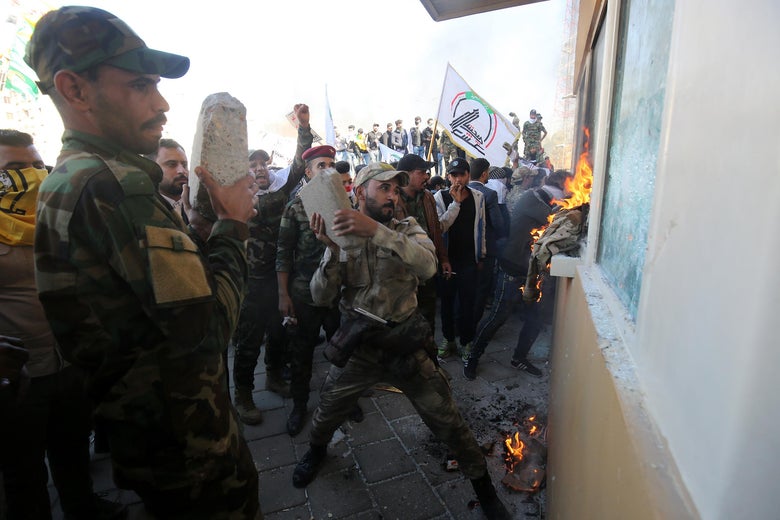
Members the Hashed al-Shaabi, a mostly Shiite network of local armed groups trained and armed by powerful neighbour Iran, smash the bullet-proof glass of the US embassy’s windows in Baghdad with blocks of cement after breaching the outer wall of the diplomatic mission on December 31, 2019 to vent their anger over weekend air strikes that killed pro-Iran fighters in western Iraq.
AHMAD AL-RUBAYE/Getty Images
Dozens of militia members and their supporters burst into the heavily guarded U.S. Embassy compound in Baghdad and set fires while chanting “Death to America” to protest U.S.
airstrikes carried out Sunday against three camps in Iraq and two in Syria. The American airstrikes killed 24 members of an Iranian-backed militia, the Kataeb Hezbollah, in retaliation for last week’s killing of an American contractor in a rocket attack on an Iraqi military base. President Donald Trump issued an angry response to the protests and blamed Iran for the storming of the U.S. embassy compound. “Iran killed an American contractor, wounding many,” Trump tweeted. “We strongly responded, and always will. Now Iran is orchestrating an attack on the U.S. Embassy in Iraq. They will be held fully responsible. In addition, we expect Iraq to use its forces to protect the Embassy, and so notified!”
American guards fired tear gas to try to keep protesters back. At least initially the protesters, many of whom were wearing militia uniforms, did not enter the main embassy buildings and withdrew from the compound to rejoin the thousands of protesters who were outside to protest the U.S. action. Some of those protesters erected tents as some said they would continue protesting indefinitely until all U.S. diplomats and troops leave the country.
Although no casualties were reported, it was still one of the worst attack on the embassy in recent years. Iraqi security forces did not really make an effort to prevent the protesters from entering the embassy compound but later “took steps to prevent them going farther inside the facility only after an Iraqi army commander arrived and ordered them to do so,” reports the Washington Post. The way the protesters were able to storm one of the most heavily guarded areas of Baghdad “suggested that they had received at least tacit permission from Iraqi security officials sympathetic to their demands,” notes the New York Times.
The lack of immediate action by Iraqi security forces illustrates just how big of a crisis has been sparked by the U.S. airstrikes on Sunday that have managed to fan the flames of anti-Americanism while giving Iran an upper hand for influence in the country. The airstrikes didn’t just anger the militia but also the Iraqi government that it called a “flagrant violation” of its sovereignty. Iraq’s caretaker Prime Minister Adel Abdul-Mahdi told Cabinet members Monday that he tried to stop the airstrikes but was unsuccessful due to “insistence” from U.S: officials. He also declared three days of mourning for the victims of the airstrikes.
As tensions rise between the United States and Iran, proxy battles in the region seem likely to increase, explained Slate’s Joshua Keating on Monday. “Because both the U.S. and Iran are so deeply enmeshed in Iraqi politics, it may well turn out to be ground zero for this conflict,” Keating wrote.
Readers like you make our work possible. Help us continue to provide the reporting, commentary and criticism you won’t find anywhere else.
Join Slate Plusfrom Slate Magazine https://ift.tt/35aYUaq
via IFTTT
沒有留言:
張貼留言